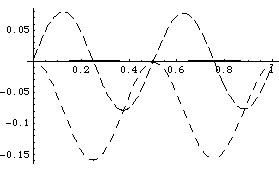10.4.6 Reducing Gyroscopic ModelsThere is one more technique that can be applied to 3D gyroscopic models to reduce their size and thereby reduce their run time. This technique can be very useful to models with more than one rotor. A function for modifying an inertia tensor. The restrictions that apply to the use of GyroFilter are identical to the restrictions that apply to the use of GyroMoment. The body represented by the inertia properties must be axially symmetric. The purpose of GyroFilter is to make it possible to add a zero-torque spinning body to a model without actually adding a body to the model at all. To demonstrate, the rotor body is deleted from the previously defined gyroscope model, and replaced with a special load and inertia properties on the gimbal. This time, the model is built in Euler coordinates, just to show that the results are the same. Here is the gyroscope constraint set with the rotor deleted. Here is the body object for the gimbal. It now carries the inertia of what was the rotor with the component in the direction of the spin axis (the local X axis) of the rotor filtered out. Note the return from GyroFilter; the X component of the inertia is gone.
Out[30]= |  |
Here are the load objects. They are unchanged, except that GyroMoment uses the inertia option to explicitly specify the inertia properties. If this was not done, GyroMoment would pull the inertia properties from the body object that has previously had the X component filtered out. The model is now functionally equivalent to the previously defined model. The model can be integrated with SolveFree, after dropping constraints 2 and 4. Constraint 6 was previously dropped and is no longer part of the model. The model is integrated from T = 0 to 1. Here is a plot of the angular velocity components of the gimbal. It is identical to the response of the previous model, with only two bodies required to create it.

Out[35]= |  |
|